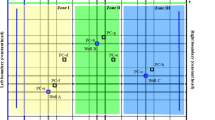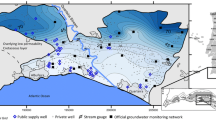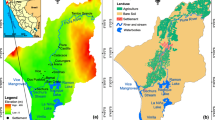Abstract
Delayed yield phenomenon (DYP) occurs when the drawdown of an aquitard is no longer in equilibrium owing to previous changes in the level of water in adjacent aquifers. In this study, an analytical solution to determine the distribution of the drawdown at any time and at any point in an aquitard, in which the water level was not in equilibrium at the initial time, and the water level of the aquifers immediately above and below the aquitard was time dependent was developed. The analytical solution for the flow rate at any time and location was presented based on variations in drawdown in the aquitard. In addition, the effects of the DYP on the leakage rate and depletion of the aquitard were studied. Subsequent comparison of the proposed analytical and numerical solutions revealed that they were in good agreement. The results of this study will be useful to future studies of groundwater flow and environmental problems, such as water budgets, rising sea levels, solute transport, heat conduction and ground subsidence.










Similar content being viewed by others
References
Alley WM, Leake SA (2004) The Journey from Safe Yield to Sustainability. Gr Water 42(1):12–16
Cheng AHD, Morohunfola OK (1993) Multilayered leaky aquifer systems: 1. Pumping well solutions. Water Resour Res 29(8):2787–2800
Cihan A, Zhou Q, Birkholzer JT (2011) Analytical solutions for pressure perturbation and fluid leakage through aquitards and wells in multilayered-aquifer systems. Water Resour Res 47(10):W10504. doi:10.1029/2011WR010721
Döll P (2009) Vulnerability to the impact of climate change on renewable groundwater resources: a global-scale assessment. Environ Res Lett 4(3):035006. doi:10.1088/1748-9326/4/3/035006
Ehlig C, Halepaska JC (1976) A numerical study of confined-unconfined aquifers including effects of delayed yield and leakage. Water Resour Res 12(6):1175–1183
Glee GD (1930) Over grond water stroomingen Wateronttrekking door Middel van Putten. Jr., Delft, J. Waltman
Gleeson T, VanderSteen J, Sophocleous MA, Taniguchi M, Alley WM, Allen DM, Zhou Y (2010) Groundwater sustainability strategies. Nat Geosci 3(6):378–379
Gleeson T, Alley WM, Allen DM, Sophocleous MA, Zhou Y, Taniguchi M, VanderSteen J (2012) Towards sustainable groundwater use: setting long-term goals, backcasting, and managing adaptively. Gr Water 50(1):19–26
Gornitz V (2001) Impoundment, groundwater mining, and other hydrologic transformations. In: International geophysics impacts on global sea level rise, 5rd edn. Academic Press, pp 97–119
Hanasaki N, Kanae S, Oki T, Masuda K, Motoya K, Shirakawa N, Shen Y, Tanaka K (2008) An integrated model for the assessment of global water resources—Part 2: applications and assessments. Hydrol Earth Syst Sci 12(4):1027–1037
Hantush MS (1960) Modification of the theory of leaky aquifers. J Geophys Res 65(11):3713–3725
Hantush MS (1967) Flow to wells in aquifers separated by a semipervious layer. J Geophys Res 72(6):1709–1720
Hemker CJ (1984) Steady groundwater flow in leaky multiple-aquifer systems. J Hydrol 72(3–4):355–374
Hemker CJ (1985) Transient well flow in leaky multiple-aquifer systems. J Hydrol 81(1–2):111–126
Hemker CJ, Maas C (1987) Unsteady flow to wells in layered and fissured aquifer systems. J Hydrol 90(3–4):231–249
Herrera I (1970) Theory of multiple leaky aquifers. Water Resour Res 6(1):185–193
Herrera I, Figueroa V, Germán E (1969) A correspondence principle for the theory of leaky aquifers. Water Resour Res 5(4):900–904
Hunt B (1985) Flow to a well in a multiaquifer system. Water Resour Res 21(11):1637–1641
Jacob CE (1946) Radial flow in a leaky artesian aquifer. Trans Am Geophys Union 27(2):198–205
Konikow LF (2011) Contribution of global groundwater depletion since 1900 to sea-level rise. Geophys Res Lett 38:L17401. doi:10.1029/2011GL048604
Konikow LF, Kendy E (2005) Groundwater depletion: a global problem. Hydrogeol J 13(1):317–320
Konikow LF, Neuzil CE (2007) A method to estimate groundwater depletion from confining layers. Water Resour Res 43:W07417. doi:10.1029/2006WR005597
Maas C (1987a) Groundwater flow to a well in a layered porous medium: 1. Steady flow. Water Resour Res 23(8):1675–1681
Maas C (1987b) Groundwater flow to a well in a layered porous medium: 2. Nonsteady multiple-aquifer flow. Water Resour Res 23(8):1683–1688
Malama B, Kuhlman KL, Barrash W (2007) Semi-analytical solution for flow in leaky unconfined aquifer–aquitard systems. J Hydrol 346(1–2):59–68
Morris BL, Lawrence ARL, Chilton PJC, Adams B, Calow RC, Klinck BA (2003) Groundwater and its susceptibility to degradation: a Global Assessment of the Problem and Options for Management, Nairobi, Kenya, United Nations Environment Programme (UNEP) Early Warning and Assessment Report Series. RS 03–3:126
Neuman SP (1979) Perspective on ‘Delayed yield’. Water Resour Res 15(4):899–908
Neuman SP, Gardner DA (1989) Determination of aquitard/aquiclude hydraulic properties from arbitrary water-level fluctuations by deconvolution. Ground Water 27(1):66–76
Neuman SP, Witherspoon PA (1968) Theory of flow in aquicludes adjacent to slightly leaky aquifers. Water Resour Res 4(1):103–112
Neuman SP, Witherspoon PA (1969a) Theory of flow in a confined two aquifer system. Water Resour Res 5(4):803–816
Neuman SP, Witherspoon PA (1969b) Applicability of current theories of flow in leaky aquifers. Water Resour Res 5(4):817–829
Neuzil CE (1986) Groundwater flow in low-permeability environments. Water Resour Res 22(8):1163–1195
Neuzil CE (1994) How permeable are clays add shales. Water Resour Res 30(2):145–150
Villholth K (2006) Groundwater assessment and management: implications and opportunities of globalization. Hydrogeol J 14(3):330–339
Walton WC (1979) Progress in analytical groundwater modeling. J Hydrol 43(1–4):149–159
Xie KH, Leo CJ (2004) Analytical solutions of one-dimensional large strain consolidation of saturated and homogeneous clays. Comput Geotech 31(4):301–314
Yang Y, Aplin AC (2007) Permeability and petrophysical properties of 30 natural mudstones. J Geophys Res 112(B3):B03206
Yang Y, Aplin AC (2010) A permeability–porosity relationship for mudstones. Mar Petrol Geol 27(8):1692–1697
Zhan H, Bian A (2006) A method of calculating pumping induced leakage. J Hydrol 328(3–4):659–667
Zhan H, Zlotnik VA (2002) Groundwater flow to a horizontal or slanted well in an unconfined aquifer. Water Resour Res 38(7):1108–1118. doi:10.1029/2001WR000401
Zhou Z, Guo Q, Dou Z (2013) Delayed drainage of aquitard in response to sudden change in groundwater level in adjacent confined aquifer: analytical and experimental studies. Chin Sci Bull 58(25):3060–3069. doi:10.1007/s11434-013-5730-5
Zlotnik VA, Zhan H (2005) Aquitard effect on drawdown in water table aquifers. Water Resour Res 41:W06022. doi:10.1029/2004WR003716
Acknowledgments
This study was financially supported by The National Natural Science Foundation of China (Grant No. 41402201, 41402217 and 41172204), Non-profit Industry Financial Program of the Ministry of Water Resources of China (201301083) and The Central Research Institutes of Basic Research and Public Service Special Operations (Grant no. Y313002).
Author information
Authors and Affiliations
Corresponding author
Appendix A: Derivation of the solution to (1)–(4)
Appendix A: Derivation of the solution to (1)–(4)
Because boundary conditions (3) and (4) are non-homogeneous, it was necessary to simplify the boundary conditions as follows:
Substituting u (z, t) with v (z, t) of Eq. (1), the initial condition and boundary condition leads to:
where, u 1 and u 2 are the drawdown of the aquifers lying above and below the aquitard, respectively.
The solution of Eq. (A3) was derived using the characteristic function method. The corresponding eigenfunctions of control equation (A3) were\(\left\{ {\sin \frac{m\pi z}{l}} \right\}\), so the form solution of Eq. (A3) was:
where T m (t) (m = 1, 2, 3…) is the unknown function. Obviously, (A4) satisfies the boundary conditions v (0, t) = v (l, t) = 0. Substituting Eq. (A4) into Eq. (A3) leads to
Multiplying both sides of the equation by \(\sin \frac{n\pi z}{l}\left( {n = 1,2,3 \ldots } \right)\) gives:
According to the orthogonality of trigonometric function system, equation Eq. (A6) can be simplified to:
Solving Eq. (A7) gives:
where,
The initial condition can be expressed as:
Therefore, T n (0) can be expressed by Fourier series as follows:
Substituting Eq. (A9) and Eq. (A11) into (A8) leads to:
Substituting Eq. (A12) into Eq. (A4) enables the form solution of question (A3) to be obtained as follows:
Finally, adding Equations (A2) and (A13) leads to:
Rights and permissions
About this article
Cite this article
Li, Z., Zhou, Z. An analytical solution for leakage rate and depletion of aquitard influenced by the delayed yield phenomenon. Environ Earth Sci 74, 1227–1234 (2015). https://doi.org/10.1007/s12665-015-4114-3
Received:
Accepted:
Published:
Issue Date:
DOI: https://doi.org/10.1007/s12665-015-4114-3




